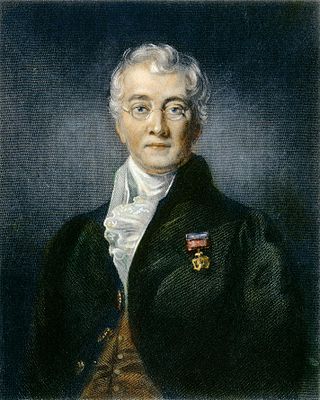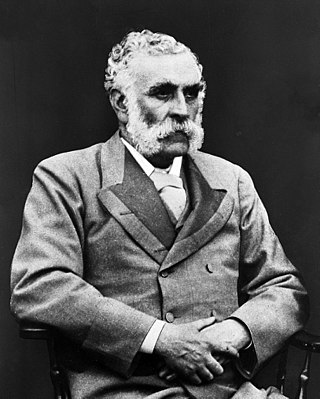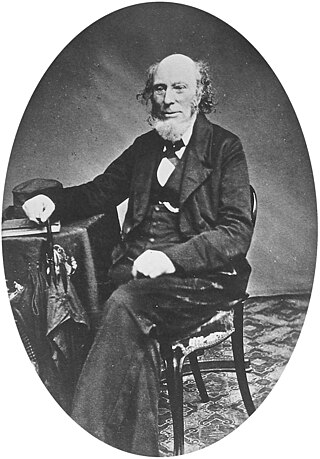Related Research Articles

The Dean Cemetery is a historically important Victorian cemetery north of the Dean Village, west of Edinburgh city centre, in Scotland. It lies between Queensferry Road and the Water of Leith, bounded on its east side by Dean Path and on its west by the Dean Gallery. A 20th-century extension lies detached from the main cemetery to the north of Ravelston Terrace. The main cemetery is accessible through the main gate on its east side, through a "grace and favour" access door from the grounds of Dean Gallery and from Ravelston Terrace. The modern extension is only accessible at the junction of Dean Path and Queensferry Road.

Sir Charles Bell was a Scottish surgeon, anatomist, physiologist, neurologist, artist, and philosophical theologian. He is noted for discovering the difference between sensory nerves and motor nerves in the spinal cord. He is also noted for describing Bell's palsy.
Sir John Weir was a Scottish physician and homeopath who served as Physician Royal to several twentieth century monarchs.

Douglas Moray Cooper Lamb Argyll Robertson FRSE, FRCSEd LLD was a Scottish ophthalmologist and surgeon. He introduced physostigmine into ophthalmic practice and the Argyll Robertson pupil is named after him. He was president of the Royal College of Surgeons of Edinburgh.

William Henderson was a conventionally trained Scottish physician who became an influential advocate for homeopathy in Great Britain.

Sir Andrew Douglas MaclaganPRSE FRCPE FRCSE FCS FRSSA was a Scottish surgeon, toxicologist and scholar of medical jurisprudence. He served as president of 5 learned societies: the Royal Medical Society (1832), the Royal College of Surgeons of Edinburgh (1859–61), the Royal College of Physicians of Edinburgh (1884–87), the Royal Society of Edinburgh (1890–5), and the Royal Scottish Society of Arts (1900).
Angus Macdonald FRSE FRCPE, was a Scottish physician, obstetrician and lecturer at the University of Edinburgh. He served as President of the Edinburgh Obstetrical Society from 1879 to 1881.

John Burns FRS MIF was a Scottish surgeon.

Charles Murchison was a British physician and a noted authority on fevers and diseases of the liver.
Thomas Jones Mackie CBE FRSE LLD was a noted Scottish bacteriologist; Dean of the Faculty of Medicine, University of Edinburgh; and author of medical research textbooks.

Sir Henry Duncan Littlejohn MD LLD FRCSE was a Scottish surgeon, forensic scientist and public health official. He served for 46 years as Edinburgh's first Medical Officer of Health, during which time he brought about significant improvements in the living conditions and the health of the city's inhabitants. He also served as a police surgeon and medical adviser in Scottish criminal cases.

Allen Thomson FRS FRSE FRCSE was a Scottish physician, known as an anatomist and embryologist.

Charles Frederick William Illingworth was a British surgeon who specialised in gastroenterology. Along with a range of teaching and research interests, he wrote several surgical textbooks, and played a leading role in university and medical administration.
James Black FRSE FGS (1787–1867) was a Scottish physician, geologist and paleontologist who investigated the capillary circulation of the blood (1825), as well as matters of fever and bowels.

David Maclagan MD, FRSE, FRCSEd, FRCPE was a prominent Scottish medical doctor and military surgeon, serving in the Napoleonic Wars. He served as President of both the Royal College of Physicians of Edinburgh and the Royal College of Surgeons of Edinburgh. He was Surgeon in Scotland to Queen Victoria.

Robert James Blair Cunynghame of Cronan, FRCSEd, FRSE JP was a prominent Scottish surgeon, physiologist and early forensic scientist in the late 19th century. He served as President of the Royal College of Surgeons of Edinburgh from 1891 to 1893. He is said to have had a calm, beautiful face and his opinion was used as a benchmark to medical thought.
Prof Thomas Gibson FRSE (1915-1993) was an eminent Scottish plastic surgeon serving as Professor of Plastic Surgery and Bioengineering at Strathclyde University. Together with Robert Kenedi he cofounding the Bioengineering Department in 1961. His research forms the basis for modern tissue transplantation techniques. In 1960 Sir Peter Medawar wrote to Gibson giving "deep obligation" to him for paving the way for his understanding which led to Medawar being awarded the Nobel prize for Medicine in 1960. His letter ended "thank God I was lucky enough to team up with you".
Dr John George Sinclair Coghill FRCPE FSA(Scot) (1834–1899) was a medical doctor specializing in obstetrics and respiratory complaints, especially tuberculosis, and was one of the earliest European medical doctors to travel to China and Japan. He also served in the Crimean War and later trained under Sir James Young Simpson.

Sir Hector Clare Cameron was a surgeon who was most notable for being Emeritus Professor of Clinical Surgery at the University of Glasgow and President of the Faculty of Physicians and Surgeons of Glasgow between 1897 and 1900. Cameron was house-surgeon to Joseph Lister and by 1887 assisted him in private practice. They eventually became life-long friends.
John Rutherford Ryley was an Australian surgeon who studied medicine in Glasgow, where he learned about Listerian antisepsis from Joseph Lister. He emigrated to New Zealand and introduced antiseptic surgery there in January 1868. Most of his career was then spent in Australia. He killed himself at the age of 46.
References
- ↑ British Medical Journal, 25 October 1879, p.677
- ↑ British Medical Journal, 25 October 1879, p.677
- ↑ "Dr John Gibson Fleming, Visiting Surgeon, 1839-1878". Wellcome Library. Retrieved 28 December 2018.
- ↑ Biographical Index of Former Fellows of the Royal Society of Edinburgh 1783–2002 (PDF). The Royal Society of Edinburgh. July 2006. ISBN 0-902-198-84-X. Archived from the original (PDF) on 24 January 2013. Retrieved 12 May 2016.
- 1 2 "TheGlasgowStory: John Gibson Fleming". www.theglasgowstory.com. Retrieved 2 August 2021.
- ↑ Glasgow Post Office Directory 1879
- ↑ British Medical Journal, 25 October 1879, p.678
- ↑ British Medical Journal, 25 October 1879, p.678